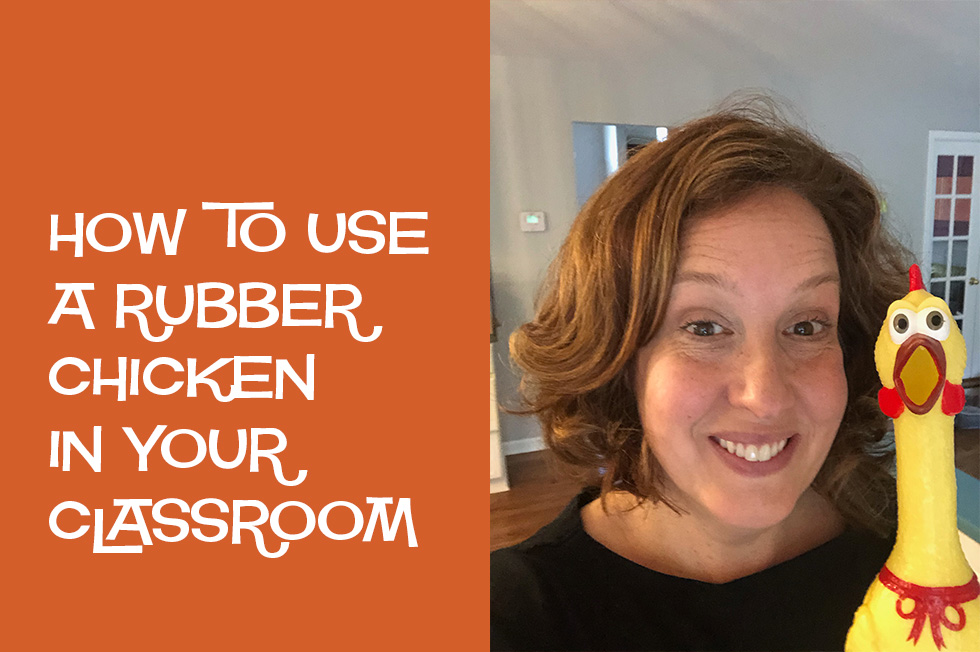Oftentimes, to create an inclusive classroom we have to be thinking outside the box, or outside of a lot of boxes, so we are sure to include ALL learners. Now with a lot of teaching being done in virtual classrooms, it is even more important to be thinking about how we can adapt our lessons to make them fun, engaging and relevant to each of our students.
A rubber chicken is an awesomely underrated tool to get this job done.
Whether you are in-person or remote, here are 20 ideas we have incorporated a rubber chicken in our instruction.
- Talking object: Like a puppet; can give directions, share feelings/ideas, clarify tasks, ask questions, co-teach
- Signaling a transition: Squeak for gaining attention
- Rubber chicken tag: If you get tagged your turn to share (works best if in-person)
- Turn and talk partner: Everyone has a rubber chicken to talk with
- Read aloud: The chicken can be a read-aloud partner or buddy
- Class “pet”: Learn how to care for others without having to clean a cage
- Job chart: Someone is in charge of it and takes it under their “wing”
- As a “reward”: If you are ready, if your desk is clean, if you would enjoy it– you are in charge of the chicken
- Play “Hot Chicken”: Throw while the music plays… when it stops… if you have a chicken you share an answer
- Play Simon Says:
- catch by the head (think about),
- neck (stretch)
- feet (action)
- belly (notice how you feel)
- Get moving:
- toss and clap; toss into a hula hoop
- “chick flick” – from foot
- “bucket of chicken” – catch it in a bucket
- do the “chicken dance”
- Practice concentrating: Balance the chicken on your head
- Answer questions: Squawk your chicken when you have an answer
- “Visit” the Rubber Chicken Museum: Google the museum and go on a virtual scavenger hunt
- Shauna Iverson: Interview the “High Priestess” of rubber chickens
- Chicken scratch: Discover that writing with a pencil is sometimes called “chicken scratch”
- Root cause analysis: Why did the chicken cross the road?
- Discuss: Which came first, the chicken or the egg?
- Fly the coop: A break card substitute—”I need to get out of here”
- Math: Group chickens by size, shape or length
We really enjoy our rubber chicken co-teachers and all that they help us teach.
What are some other ways you have used a rubber chicken in your teaching? If you haven’t used a rubber chicken, we challenge you to give him/her a chance and see what happens. Grab a picture of you and your rubber chicken and tag us on social media (@inclusiveschooling) we can’t wait to see what you come up with!
Making Fun a Little Bit Brainy:
There is substantial research across disciplines that provides evidence that fun improves behavior and learning for ourselves and our students. Brain research suggests that fun is beneficial to learning because fun increases dopamine, endorphins, and oxygen, which encourages motivation for and retention of learning (Willis, 2007). By several reports, positive emotions can produce increased academic achievement and authentic learning (Um, Plass, Hayward, & Homer, 2012), including retention and long-term memory (Tyng, Amin, Saad, & Malik, 2017).
When we are in positive emotional or physical states, we trigger optimal brain activation. We feel positive when we can connect material to our personal life or interests, when learning is presented in an interesting or exciting way, when our curiosity is piqued, or even when we are simply laughing and playing with others (Willis, 2007).

